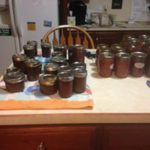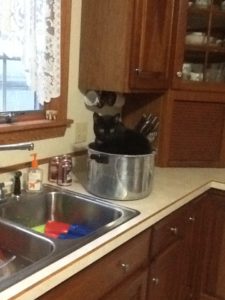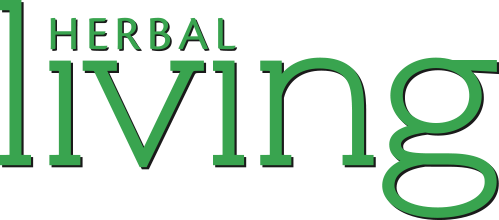Cottage Food Laws
Cottage food laws allow small-scale individuals to produce particular food items using their home kitchens without governmental oversight. Baking, cooking, canning, pickling, and producing other low-risk food items are a few options. Cottage food laws by design help give the small people a break. Affording small-time producers, the opportunity to try out a food-based business without having to go
through all the expenses and legality of preparing a commercial kitchen.

Homemade Blueberry Zucchini Bread
Baked Goods
Each state has its own defined cottage laws but a good rule of thumb is if a food requires refrigeration, such as custard pie, then it is high-risk and cannot be sold. However, baked-goods such as banana bread are most likely ok. Even though many baked goods contain high-risk ingredients such as dairy and eggs, they are still considered low-risk because of them being cooked and no longer requiring refrigeration.

Apple Butter
Canned Food
The biggest fear in canned goods is botulism, therefore; cottage laws typically do not allow low-acid food. Therefore, most home-canned vegetables and meats are strictly prohibited. However, high-acid foods, as well as good sanitization practices, lower the risk of botulism. Thus, canning acidic foods for sales such as fruits, jellies, and jams is typically allowed.
So, what other items are allowed?
Well, this depends solely on your state’s rules, regulations, and guidelines. For instance, in Ohio, there is a 75% rule. For many products, 75% of the contents need to be from the seller’s property or collected by the seller. What do I mean? Let us take honey, for instance, a minimum of 75% of the honey must be from the beekeeper’s own hives in order to legally sell under the Cottage Law. When it comes to Maple Syrup, at least 75% of the sap used to produce the Maple Syrup must be collected directly from trees by the processor.

Just a funny pic of my cat Ollie.
Labeling
Just because you can get out of food inspections and licenses under Cottage Law does not mean there are no other legalities that need to be followed. Labeling is extremely important! In the state of Ohio, the following rules apply.
The name and address of where the product was produced must be on the package.
The name of the food product – Ex: “Chocolate Chip Cookies”
The ingredients of the food product, in descending order by weight. This means your heaviest ingredient need to be listed first and the least heavy ingredient listed last. In addition, ingredients must be broken down completely. Such as if, the ingredient contains two or more ingredients. For example, if unsalted butter were one of your ingredients, then you would list it as follows: Butter (Sweet Cream, Natural Flavor).
The net quantity of the product must be labeled in both (inch/pound) and (metric system). This has to be placed within the bottom 30% of the label in a line parallel to the bottom of the package. An example of what this would look like is: Net Wt 8 oz (227 g)
The following statement in ten-point type: “This product is home produced.” This statement is required to give notice to the purchaser that the product is not required to be inspected by a food regulatory authority.
Allergen Statement. There are 8 foods considered a major food allergen under the Food Allergen Labeling and Consumer Protection Act that must be declared on your label if they are contained in your food product. They include:
-
- Milk
- Egg
- Fish – For fish, the specific species must be declared – Ex: Crappy
- Crustacean Shellfish, the specific species must be specified – Ex: Crab
- Tree Nuts – For tree nuts, the specific type of nut must be declared – Ex: Almond
- Wheat
- Peanuts
- Soybeans
Label in one of two ways.
- You can list the allergens in a “Contains” statement. The “Contains” statement would follow the ingredients list and look like this: “Contains: Wheat, Egg.”
- The allergen is in your ingredients list. An example would be “Enriched flour” (wheat flour, malted barley, niacin, reduced iron, thiamin monotrate, riboflavin, folic acid).

Chicken Stock is not allowed in Ohio
Most importantly for anyone thinking about producing and selling under a state Cottage Law, “READ YOUR STATE LAWS CAREFULLY”. Know the guidelines and follow the rules to a T. The last thing you want to do is get into legal trouble or make someone sick because you chose to cut corners. Each state not only has laws on what items may be produced but also where the product can be legally sold under the Cottage Law as well. Check your state rules.
For more information on Ohio Cottage Law, check out Farm Office Ohio State University Extension website.
Follow Me
FACEBOOK•MILLER MICRO FARM•COMMUNITY CHICKENS•MOTHER EARTH NEWS•GRIT MAGAZINE•HOMESTEAD HUSTLE

Homemade honey bread is Ok in Ohio










